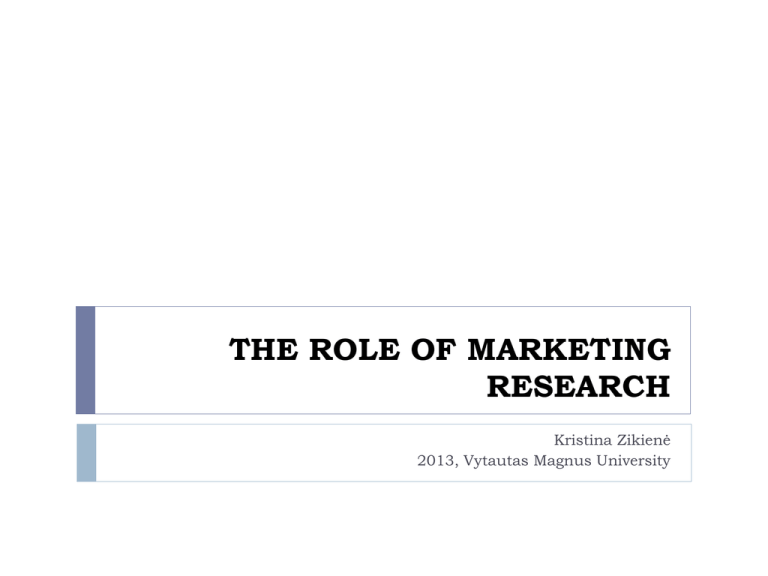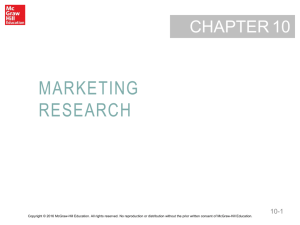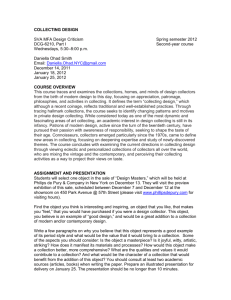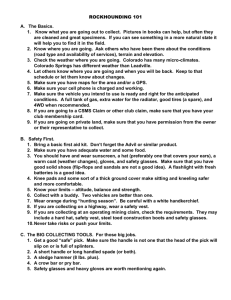THE ROLE OF MARKETING RESEARCH
advertisement

THE ROLE OF MARKETING RESEARCH Kristina Zikienė 2013, Vytautas Magnus University Nature of Marketing Marketing is the activity, set of institutions, and processes for creating, communicating, delivering, and exchanging offerings that have value for customers, clients, partners, and society at large. To make the “right” desicions, based on marketing activities, management must have timely decision – making information. MARKETING RESEARCH IS A PRIMARY CHANNEL FOR PROVIDING THAT INFORMATION. KEY ROLES OF MARKETING RESEARCH First, as part of the marketing intelligence feedback process, marketing research provides decision makers with data on the effectiveness of the current marketing mix and offers insights into necessary changes; Second, marketing research is the primary tool for exploring new oportunities in the marketplace (f.e. segmentation research and new product research help identify the most lucrative opportunities for a firm). Marketing Research Defined Marketing research is the function that links the customer, consumer, and public to the marketer through information – information used to identify and define marketing opportunities and problems; generate, refine, and evaluate marketing actions; monitor marketing performance; and improve understanding of marketing as a process. Marketing research specifies the information to required to address these issues, designs the method for collecting information, manages and implements the data collection process, analyzes the results, and communicates the findings and their implications (American Marketing Association ) Marketing Research Defined Marketing research is the planning, collection, and analysis of data relevant to marketing decision making and the communication of the results of this analysis to management. What is Marketing Reseach? ORGANIZATION Collecting information MARKET Marketing Research Defined Marketing research is defined as the systematic and objective process of generating information for aid in making marketing desicions. WHAT DOES IT MEAN SYSTEMATIC AND OBJECTIVE? Systematic means that information is not intuitive or haphazardly gathered. The term connotes patient study and scientific investigation wherein the researcher takes another, more careful look at the data to discover all that is known about the subject. Objective means, that if the information generated, or data collected and analyzed, is to be accurate, the marketing research must be objective. The researcher should be detached and impersonal rather than biased, attempting to support his or her preconceived ideas. If bias enters into the research procces, its value is considerably reduced. Importance of Marketing Research to Management Marketing research can be viewed as playing three functional roles: Descriptive function • Includes gathering and presenting statements of fact. Diagnostic function • The explanation of data or actions. Predictive function • Specification of how to use descriptive and diagnostic research to predict the results of a planned marketing decision. The objects of Marketing Research Marketing research is used to gather information about: Company’s macro – environment (Political, Economic, Socio – cultural, Environmental and Technological) Company’s micro – environment (Customers, Suppliers, Employees, Competitors, Media, Shareholders) Marketing Mix (Product, Price, Promotion, Place) Customers (Behaviours, Attitudes, Desicions, Oppinion, Life style,Values, Sociodemographic characteristics and so on...) Planning and Implementing a Marketing Mix Product Research Product research takes many forms and includes studies designed to evaluate and develop new products and to learn how to adapt existing product lines. Consept testing exposes potential customers to new-products ideas to judge the concepts’ acceptance and feasibility. Product testing determines a product prototype’s strengths and weaknesses or whether a finished product performs better than competitive brands or according to expectations. Brand name evaluation studies investigate whether the name is appropriate for the product. Package testing assesses size, color, shape, ease of use and other attributes of the package. Planning and Implementing a Marketing Mix Pricing Research Research for learning the ideal price level or determining if a price high enough to cover costs; Can help answer the question, is there a need for seasonal or quantity discount? Can help answer the question, are coupons more effective than price reductions? Can help answer the question, is a brand price elastic or price inelastic? Can help answer the question, how much of a price difference is best to differentiate items in the product line? Planning and Implementing a Marketing Mix Distribution Research Used to decide about retail sites or warehouse locations; May be conducted because the actions of one channel member can greatly affect the performances of other channel members; Is needed to gain knowledge about retailer’s and wholesaler’s operations and/or to learn their reactions to a manufacturer’s marketing policies. Planning and Implementing a Marketing Mix Promotion Research Investigates the effectivness of premiums, coupons, sampling deals, and other sales promotions; Includes buyer motivation studies to generate ideas for copy development, media research, and studies of advertising effectivness; Helps advertisers decide whether television, newspapers, magazines, or other media alternatives are the best suited for conveying the advertiser’s message. Planning and Implementing the Integrated Marketing Mix The individual elements of the marketing mix do not work independently of the other elements of the marketing mix. Hence, many research studies investigate various combinations of marketing ingredients to gather information on what would be the best possible marketing program. Classification of Marketing Research Descriptive v.s. Analytical Applied v.s Fundamental Quantitative v.s. Qualitative Classification of Marketing Research Descriptive also known statistical Research; include surwey and facts; gather sociodemograpfic data. Analytical Use facts or information already awailable Classification of Marketing Research Applied Designed to solve practical problem of the modern world; For example, applied researches may investigate ways to: Improve agricultural crop production; Treat or cure a specific desease; Improve the energy efficiency at homes, offices... Fundamental Driven by a scientists in a scientific question; The main motivation is to expand Man’s knowledge, not to create or invent something: How did the universe begins? What are protons composed of? Classification of Marketing Research Quantitative: •Used to measure how many people feel, think or act in a particular way; •Many vehicle used for collecting quantitative information, mostly researches use surveys, observations and experiments. Qualitative: •Used to help us understand how people feel and why they feel as they do •It is concerned with collecting in-debt information asking questions such as why do you say that •Depth interviews or group discussions are two common methods used for collecting qualitative information. • Classification of Marketing Research Companies that carry out research studies mostly do that for two reasons: identificate problem (Problem Identification Research); solve the problem (Problem Solving Research). Classification of Marketing Research Problem Identification Research Research undertaken to help identify problems which are not necessarily appatent on the surface and yet exits or are likely to arise in the future. Examples: market potential, market share, image, market characteristics, sales analysis, forecasting and trends research. Problem Solving Research Research undertaken to help solve specific marketing problems. Examples: segmentation, product, pricing, promotion, and distribution research. Decision to Conduct Marketing Research Resources are lacking; Research results would not be useful; The opportunity has passed; The decision already has been made; Managers cannot agree on what they need to know to make a decision; Decision – making information already exists; The cost of conducting research outweigh the benefits











